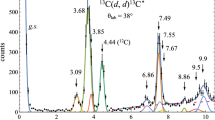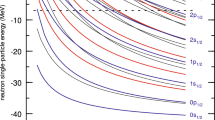Summary
In order to understand the significance of the well-known discrepancy of 45 ppm in the hydrogen hyperfine structure we have calculated the polarization correction using an isobar model for the proton, and compared the sensitivity to electron-proton forces of the analysis of the hyperfine splitting with that of the Lamb shift and of electron-proton scattering. A methodological innovation of the calculation is the avoidance of the Rarita-Schwinger formalism for spin 3/2 by the construction of a covariant analytic amplitude from the familiar non-relativistic partial-wave amplitude. It is found that the 3-3 isobar, and by extension higher resonances, are more than an order of magnitude too small to be significant and that the discrepancy is genuine. We consider the introduction of a phenomenological electron-proton interaction term, representing unknown or neglected forces, to account for the discrepancy, and find that this would not necessarily lead to a contradiction with Lamb shift or electron-proton scattering data. We point out that, whatever the cause of the discrepancy, it is likely to be proportional, in percent, to the electron mass, so that it would be roughly 200 times greater in μ-mesic hydrogen (μ−-p) than in hydrogen. We strongly encourage a measurement of the hyperfine splitting of μ-mesic hydrogen, of sufficient accuracy to determine whether the discrepancy is common to both systems and proportional to the lepton mass.
Riassunto
Per comprendere il significato della ben nota discrepanza di 45 p.p.m. nella struttura iperfina dell’idrogeno si è calcolata la correzione di polarizzazione facendo uso di un modello isobarico del protone, e si è confrontata la sensibilità alle forze elettrone-protone dell’analisi della separazione iperfina con quella dello spostamento di Lamb e dello scattering elettrone-protone. Una innovazione metodologica del calcolo sta nell’evitare il formalismo di Rarita-Schwinger per lo spin 3/2 con la costruzione a partire dalla familiare ampiezza d’onda parziale non relativistica di un’ampiezza analitica covariante. Si trova che l’isobare 3-3, e per estensione le risonanze più elevate, sono per più di un ordine di grandezza troppo piccole per essere significative e che la discrepanza è genuina. Per render conto della discrepanza, si prende in considerazione l’introduzione di un termine di interazione elettrone-protone fenomenologico, che rappresenta forze ignote o trascurate, e si trova che questo non porterebbe necessariamente ad una contraddizione con i dati dello spostamento di Lamb e dello scattering elettrone-protone. Si mette in rilievo che, qualunque sia la causa della discrepanza, è verosimile e che essa sia proporzionale, in percentuale, alla massa dell’elettrone, di modo che sarebbe grossolanamente 200 volte maggiore nell’idrogeno μ-mesico (μ−-p) che nell’idrogeno. Si raccomanda fortemente una misura della separazione iperfine dell’idrogeno μ-mesico, di accuratezza sufficiente per determinare se la discrepanza è comune ad entrambi i sistemi e proporzionale alla massa del leptone.
Similar content being viewed by others
Literatur
After the stencils were prepared, it came to our attention that this increase was also pointed out in Yale reportYale Study on High-Intensity Proton Accelerators Internal Report Y. 12, by the Yale design study group, page II.90. We are grateful to Prof.V. Hughes for informing us of the present experimental possibilities of hyper-fine-structure measurements and alternative and more accurate determination of the fine-structure constant.
P. Kusch:Phys. Rev.,100, 1188 (1955); andJ. P. Wittke andR. H. Dicke:Phys. Rev.,103, 620 (1956).
L. W. Anderson, F. M. Pipkin andJ. C. Baird:Phys. Rev.,120, 1279 (1960).
S. B. Crampton, D. Kleppner andN. F. Ramsey:Phys. Rev. Lett.,11, 338 (1963).
A. J. Layzer:Nuovo Cimento,33, 1538 (1964).
D. Zwanziger:Nuovo Cimento,34, 77 (1964).
Dr.L. Brown informs us that calculations are under way to check the recoil and finite-size effects.
W. E. Cleland, J. M. Bailey, M. Eckhause, V. W. Hughes, R. M. Mobley, R. Prepost andJ. E. Rothberg:Phys. Rev. Lett.,13, 202 (1964). We refer to this letter for the comparison of various theoretical and experimental quantities.
R. Arnowitt:Phys. Rev.,92, 1002 (1953).
W. A. Newcomb andE. E. Salpeter:Phys. Rev.,97, 1146 (1955).
C. Zemach:Phys. Rev.,104, 1771 (1956).
C. K. Iddings andP. M. Platzman:Phys. Rev.,113, 192 (1959).
M. Gell-Mann andK. Watson:Ann. Rev. Nucl. Sci.,4, 234 (1954).
M. Gourdin andPh. Salin:Nuovo Cimento,27, 193 (1963).
M. Gourdin andPh. Salin:Nuovo Cimento,27, 309 (1963).
C. K. Iddings:Phys. Rev.,138, B 446 (1965).
Private communication fromF. Guérin andC. Bouchiat.
C. K. Iddings andP. M. Platzman:Phys. Rev.,115, 919 (1959).
D. Flamm andW. Kummer:Nuovo Cimento,28, 33 (1963); [eq. (26)]. We have not checked this work.
J. Schwinger:Phys. Rev.,73, 416 (1948);A. Peterman:Helv. Phys. Acta,30, 407 (1957);C. Sommerfeld:Phys. Rev.,107, 328 (1957).
N. M. Kroll andF. Pollock:Phys. Rev.,84, 594 (1951);R. Karplus, A. Klein andJ. Schwinger:Phys. Rev.,84, 597 (1951).
A. J. Layzer:Journ. Math. Phys.,2, 308 (1961).
D. Zwanziger:Phys. Rev.,121, 1128 (1961).
M. Sternheim:Phys. Rev.,130, 211 (1963).
This is expounded in greater detail with the present conventions inD. Zwanziger:Phys. Rev.,137, B 1535 (1965).
R. F. Stiening, E. Loh andM. Deutsch:Phys. Rev. Lett.,10, 536 (1963).
R. R. Wilson andJ. S. Levinger:Ann. Rev. Nucl. Sci.,14, 135 (1964).
S. D. Drell andS. Fubini:Phys. Rev.,113, 741 (1959).
Author information
Authors and Affiliations
Rights and permissions
About this article
Cite this article
Verganelakis, A., Zwanziger, D. Polarization contribution to the hydrogen hyperfine structure and phenomenology of the electron-proton interaction. Nuovo Cim 39, 613–634 (1965). https://doi.org/10.1007/BF02735827
Received:
Published:
Issue Date:
DOI: https://doi.org/10.1007/BF02735827




